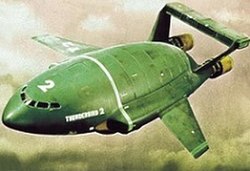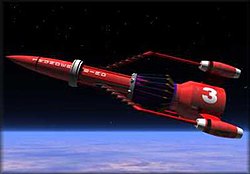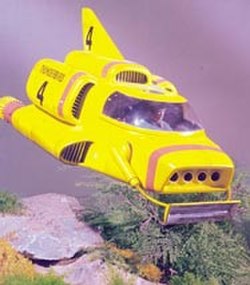Thunderbirds machines
Thunderbird 1
 |
| Affiliation |
International Rescue |
| References |
|
| General characteristics |
| Maximum speed |
15,000 mph (24,000 km/h) |
| Armaments |
Machine cannon |
| Propulsion |
4 variable-cycle gas turbine engines
4 booster rockets
1 variable mode for launch or boost
1 vertical take off variable engine for hovering |
| Power |
Atomic fusion reactor |
| Length |
115 ft (35 m) |
| Width |
80 ft (24 m) |
| Height |
115 ft (35 m) |
Thunderbird 2
 |
| Affiliation |
International Rescue |
| References |
|
| General characteristics |
| Maximum speed |
6,200 mph (10,000 km/h) |
| Armaments |
Missile launcher |
| Propulsion |
2 variable-cycle gas turbine engines
12 variable cycle cruise jets in tail plane
4 vertical take off variable engines also for hovering
4 vertical take off chemical rockets in legs |
| Power |
Atomic fusion reactor |
| Length |
250 ft (76 m) |
| Width |
180 ft (55 m) |
| Height |
60 ft (18 m) |
Thunderbird 3
 |
| Affiliation |
International Rescue |
| References |
|
| General characteristics |
| Maximum speed |
25,200 mph (40,600 km/h) (Escape Velocity) |
| Propulsion |
3 chemical rockets for launch
3 ion-drive particle accelerators for deep space
Pitch and yaw rockets; 12 in middle ring, 20 in nose, 24 at rear |
| Power |
Atomic fusion reactor |
| Length |
287 ft (87 m) |
| Width |
80 ft (24 m) |
| Height |
287 ft (87 m) |
Thunderbird 4
 |
| Affiliation |
International Rescue |
| References |
|
| General characteristics |
| Maximum speed |
Underwater 160 knots (300 km/h; 180 mph)
Surface 40 knots (74 km/h; 46 mph) |
| Armaments |
Missile tube launcher |
| Propulsion |
6 electrically driven reversible axial-flow turbine impellers
2 axial-flow turbines providing forward thrust
Emergency launch jets; 4 vertical thrust jets and 2 x 25 liquid fuel mini-rockets |
| Power |
Atomic fusion reactor |
| Length |
30 ft (9.1 m) |
| Width |
11 ft (3.4 m) |
Thunderbird 5
 |
| Affiliation |
International Rescue |
| References |
|
| General characteristics |
| Defences |
6 electromagnetic cloaking baffles
Plasma cored meteor deflector |
| Propulsion |
geosynchronous orbit 22,400 miles (36,000 km) above the pacific ocean |
| Power |
Atomic batteries |
| Length |
400 ft (120 m) |
The Gerry Anderson Supermarionation television series Thunderbirds and the subsequent feature films Thunderbirds Are Go and Thunderbird 6 (1965–68) featured a large variety of futuristic air, land and sea vehicles and machines, the majority of which were designed by special effects director Derek Meddings.
In the context of the series, most of the advanced machines appearing in the series belonged to the International Rescue organisation and were used during their rescues. These were known as the "Thunderbirds", of which there were five core machines and a variety of other rescue craft. It was after these that the series was named. In the series, all of the International Rescue vehicles were designed by the organisation's resident technical genius, Brains.
The use of these models in Anderson's Supermarionation productions beginning with Supercar was a significant advance in television production. Before Supermarionation, scale models had generally been limited to the cinema. Meddings's models introduced a new level of realism and quality; while most TV and motion picture aircraft and spacecraft of the time were clean and polished, the Thunderbirds machines (and most others in the series) show the effects of wear and tear. This dirt and wear was applied as a way of adding realism and countering the miniature models' toy-like appearance.
These effects were to be influential, and Century 21 modelmakers went on to work on Stanley Kubrick's 2001: A Space Odyssey and the EON James Bond films. The relative scale of these vehicles is a matter of debate, especially the rocket-based designs. Many of the Thunderbirds machines have subsequently been made into toys, models, kits or other merchandising, although none of the original filming models survive.
International Rescue's fleet consists of 5 principal craft; the Thunderbirds:
...
Wikipedia





